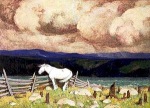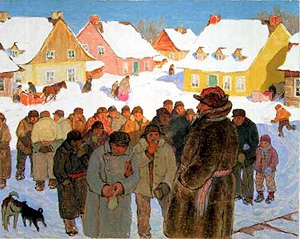Tags
Clarence Gagnon artist, colonisation, Curé Labelle colonisation, exode, Louis Hémon author, Maria Chapdelaine, Regionalism, Saguenay-Lac-Saint-Jean, three film adaptations

The Chapdelaine Farm by Clarence Gagnon
Louis Hémon[i]
French author Louis Hémon (12 October 1880 – 8 July 1913) moved to Canada in 1911. By then he had already published several books. As for his Maria Chapdelaine, he wrote it during the winter of 1912-1913, sent his manuscript to France and started travelling west.
Hémon died in a train accident at Chapleau, Ontario. Had he travelled a little further he would have met the descendants of voyageurs, Métis, and aristocrats referred to as “The French Counts.”[ii] They had settled in the Assiniboia region: Count Henri de Soras, the Marquis de Jumilhac, Viscount Joseph de Langle, Count de Beaulincourt and others.
Historical Background: two choices
- L’Exode or Exodus
Louis Hémon came to Quebec during a period of its history when there was very little work for French-speaking Canadians inhabiting Quebec and Acadia. This period of Canadian history is called the Exode. Nearly a million French Canadians and Acadians moved to the United States where they could work in factories.
- The Curé Labelle: colonisation
This could not be the Church’s best choice. One priest, the famed Curé Labelle (24 November 1833 – 4 January 1891), was the chief proponent of colonisation. He urged French-Canadians to settle north and “make land,” faire de la terre, faire du pays, as their ancestors had done. This was their mission.
—ooo—
Making Land: Samuel’s Choice
So making land had been Samuel Chapdelaine’s choice. He had taken his family to the Lac-Saint-Jean area where he and his sons were turning inhospitable land into arable soil. I should think Hémon named Samuel Chapdelaine after Samuel de Champlain, whom we could call the founder of New France.
Louis Hémon in the Saguenay-Lac-Saint-Jean
When Louis Hémon arrived in Canada, 1910, he lived in Montreal. But two years later he travelled north and stopped at Peribonka, in the Lac Saint-Jean area. At first, he worked as a farmhand, helping “settlers,” but, as noted above, he spent the winter of 1912-1913 writing Maria Chapdelaine.
Hémon had sent his manuscript to France but he never savored the success of his novel. It was serialized in France in 1914 and published by J. A. Lefebvre in Quebec in 1916, with black and white illustrations by Marc-Aurèle de Foy Suzor-Coté. It was an international bestseller. An English translation, by W. H. Blake, was published in 1921.
Maria Chapdelaine
There is summary of Maria Chapdelaine (just click on the title) on the website of the McMichael Canadian Art Collection, housed in Kleinburg, a village just north of Toronto. Clarence Gagnon‘s (8 November 1881 – 5 January 1942) 1933 illustrations of Maria Chapdelaine are part of the McMichael Canadian Art Collection.
A Summary of the Plot
However, I will summarize the summary.
Maria is the daughter of a “settler.” She is a little plump, but beautiful. One Sunday, the day on which parishioners get together and chat, Maria meets François Paradis. François is a sort of coureur des bois, voyageur, canoeman, lumberjack: the mythic fearless pioneer.
When François meets Maria, he is attracted to her and tells her that he will stop by her family’s farm before escorting Belgian travelers who are looking for fur. Maria and François fall in love. They will be married when he returns from the logging camp. However, he dies in a blinding snowstorm attempting to visit with Maria on New Year’s Eve.
Eutrope Gagnon and Lorenzo Surprenant: the other suitors
Maria has two other suitors: Eutrope Gagnon, a settler and neighbour, and Lorenzo Surprenant, who has travelled from the United States to find a bride. What Lorenzo has to offer is an easier life: no blackflies, no back-breaking labour, milder weather, nearness to a Church and to stores. She is genuinely tempted to marry him, despite the fact that she is not in love with him. For Maria, love died the day François died.
However, she rejects Lorenzo. She will marry Eutrope Gagnon, a settler, and will live as her mother lived. When she is making her decision, she hears voices telling her that in Quebec, nothing must die and nothing must change: « Au pays de Québec rien ne doit mourir et rien ne doit changer… »
The names are all symbolic: Paradis for paradise; Surprenant; for surprising or amazing; and Gagnon for winning.
My summary of Maria Chapdelaine may have diminished Maria’s suitors. But Hémon makes them very real and anxious to live their lives, which means taking a wife. Although it is a simple novel, finding a more focused, but somewhat stylized, account of life as it was in 1912 would be difficult. This novel is a jewel.
Film Adaptations
The novel was an instant, international success. In 1934, Julien Duvivier directed a film adaptation of Maria Chapdelaine starring Madeleine Renaud and Jean Gabin. A second film, entitled Naked Heart, was produced in 1950 by Marc Allégret, starring Michèle Morgan. In 1983, a third adaptation, entitled Maria Chapdelaine, was produced by Quebec filmmaker Gilles Carle, starring Carole Laure.

Folklore: À la claire fontaine, Université de Moncton, Male Choir
Maria Chapdelaine can be read online. It is a Gutenberg Project e-book. Maria Chapdelaine (Project Gutenberg, FR) [EBook #13585] Maria Chapdelaine (Project Gutenberg, EN) [EBook #4383] Maria Chapdelaine PDF Canadian literature: The Montreal School, 1895–1935 First serialized in Le Temps (1914) (Paris) Published in book form in 1916 Translated into English in 1921 (W. H. Blake) Translated in all the major languages ____________________ [i] “Louis Hémon.” Encyclopædia Britannica. Encyclopædia Britannica Online. Encyclopædia Britannica Inc., 2014. Web. 13 Jan. 2014. <http://www.britannica.com/EBchecked/topic/261010/Louis-Hemon>. [ii] Ruth Humphrys, “Dr Rudolph Meyer and the French Nobility of Assiniboia,” The Beaver (The Hudson’s Bay Company: Outfit 309:1, Summer 1978), pp. 16-23. Johannes Brahms: Drei Intermezzi, Op 117 No 2
The White Horse by Clarence Gagnon





I’m having a small issue. I cannot subscribe to your rss feed for some reason. I’m using google reader by the way.
LikeLike
Pingback: Posts on Canadian History, update, May 7, 2012 « Micheline Walker's Blog
I became honored to obtain a call coming from a friend when he uncovered the important tips shared in your site. Examining your blog write-up is a truly excellent experience. Thank you for thinking of readers just like me, and I would like for you the best of achievements as a professional in this field.
LikeLike
I just added this feed to my bookmarks. I have to say, I very much enjoy reading your blogs. Keep it up!
LikeLike
This is just what I was looking for. I was not expecting that I’d get so much out of reading your write up! You’ve just got yourself a returning visitor 🙂
LikeLike
Thank you for being my personal mentor on this subject matter. I enjoyed your current article a lot and most of all liked how you really handled the areas I thought to be controversial. You’re always rather kind to readers much like me and aid me in my existence. Thank you.
LikeLike
This page appears to get a good amount of visitors. How do you advertise it? It offers a nice individual twist on things. I guess having something authentic or substantial to talk about is the most important thing.
LikeLike
I would like to consider the chance of saying thanks to you for that professional guidance I have often enjoyed checking out your site. I will be looking forward to the particular commencement of my college research and the complete prep would never have been complete without coming over to your website. If I may be of any assistance to others, I will be ready to help through what I have learned from here.
LikeLike
Thank you.
LikeLike
You have brought up excellent details, regards for the post.
LikeLike
check out my website!
LikeLike